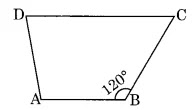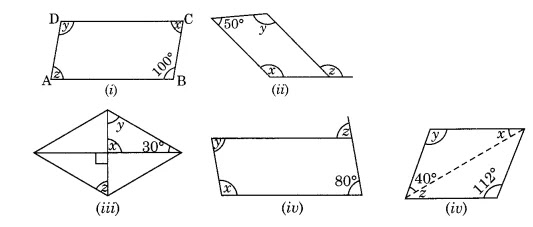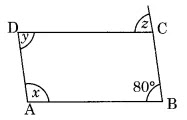NCERT Solutions for Class 8 Maths Chapter 3 Understanding Quadrilaterals Ex 3.3
Ex 3.3 Class 8 Maths Question 1.
Given a parallelogram ABCD. Complete each statement along with the definition or property used.(i) AD = …………
(ii) ∠DCB = ………
(iii) OC = ………
(iv) m ∠DAB + m ∠CDA = ……..
(i) AD
= BC [Opposite sides of a
parallelogram are equal]
(ii) ∠DCB = ∠BAD [Opposite angles of a parallelogram are equal]
(iii) OC = OA [Diagonals of a parallelogram
bisect each other]
(iv) m ∠DAB + m ∠CDA = 180°
[Adjacent
angles of a parallelogram are supplementary]
Ex 3.3 Class 8 Maths Question 2.
Consider the following parallelograms. Find the values of the unknowns x, y, z.Solution:
(i) ABCD is a parallelogram.
∠B = ∠D [Opposite angles of a parallelogram are equal]
∠D = 100°
⇒ y = 100°
∠A + ∠B = 180° [Adjacent angles of a parallelogram are supplementary]
⇒ z + 100° = 180°
⇒ z = 180° – 100° = 80°
∠A = ∠C [Opposite angles of a parallelogram are equal]
x = 80°
Hence, x = 80°, y = 100° and z = 80°
(ii) PQRS is a parallelogram.
∠P + ∠S = 180° [Adjacent angles of parallelogram are supplementary]
⇒ x + 50° = 180°
⇒ x = 180° – 50° = 130°
Now, ∠P = ∠R [Opposite angles of a parallelogram are equal]
⇒ x = y
⇒ y = 130°
Also, y = z [Alternate angles]
z = 130°
Hence, x = 130°, y = 130° and z = 130°
(iii) ABCD is a rhombus.
x = 90° [∵ Diagonals bisect each other at 90°]
Now, in ∆OCB,
x + y + 30° = 180° (Angle sum property)
⇒ 90° + y + 30° = 180°
⇒ y + 120° = 180°
⇒ y = 180° – 120° = 60°
y = z (Alternate angles)
⇒ z = 60°
Hence, x = 90°, y = 60° and z = 60°.
(iv) ABCD is a parallelogram.
∠A + ∠B = 180° (Adjacent angles of a parallelogram are supplementary)
⇒ x + 80° = 180°
⇒ x = 180° – 80° = 100°
Now, ∠D = ∠B [Opposite angles of a parallelogram are equal]
⇒ y = 80°
Also, z = ∠B = 80° (Corresponding angles)
Hence, x = 100°, y = 80° and z = 80°
(v) ABCD is a parallelogram.
∠D = ∠B [Opposite angles of a parallelogram are equal]
y = 112°
x + y + 40° = 180° [Angle sum property]
⇒ x + 112° + 40° = 180°
⇒ x + 152° = 180°
⇒ x = 180° – 152 = 28°
z = x = 28° (Alternate angles)
Hence x = 28°, y = 112°, z = 28°.
Ex 3.3 Class 8 Maths Question 3.
Can a quadrilateral ABCD be a parallelogram if(i) ∠D + ∠B = 180°?
(ii) AB = DC = 8 cm, AD = 4 cm and BC = 4.4 cm?
(iii) ∠A = 70° and ∠C = 65°?
Solution:
(i) For
∠D + ∠B = 180°,
quadrilateral ABCD may be a parallelogram if the following conditions are also
fulfilled.
(a) The sum of measures of adjacent angles
should be 180°.
(b) Opposite angles should also be of same
measures.
So,
ABCD can be a parallelogram, but need not be a parallelogram.
(ii) Given: AB = DC = 8 cm, AD = 4 cm and BC =
4.4 cm
In a parallelogram, opposite sides are equal.
Here, AD ≠ BC
Thus, ABCD cannot be a parallelogram.
(iii) ∠A = 70° and ∠C = 65°
In a parallelogram, opposite angles are equal.
Here, ∠A ≠ ∠C
Hence, ABCD is not a parallelogram.
Ex 3.3 Class 8 Maths Question 4.
Draw a rough figure of a quadrilateral that is not a parallelogram but has exactly two opposite angles of equal measure.Solution:
Here, ABCD is a rough figure of a quadrilateral in
which m ∠A = m ∠C but it is not a parallelogram. It is a kite.
Ex 3.3 Class 8 Maths Question 5.
The measures of two adjacent angles of a parallelogram are in the ratio 3 : 2. Find the measure of each of the angles of the parallelogram.Solution:
Let ABCD is a parallelogram such that ∠B : ∠C = 3 : 2.
∠B + ∠C = 180° (Adjacent angles of a parallelogram are supplementary)
3x + 2x = 180°
⇒ 5x = 180°
⇒ x = 36°
Thus, ∠B = 3 × 36 = 108°
∠C = 2 × 36° = 72°
∠B = ∠D = 108°
and ∠A = ∠C = 72°
Hence, the measures of the angles of the parallelogram are
108°, 72°, 108° and 72°.
Ex 3.3 Class 8 Maths Question 6.
Two adjacent angles of a parallelogram have equal measure. Find the measure of each of the angles of the parallelogram.Solution:
Let ABCD be a parallelogram in which ∠A = ∠B
∠A + ∠A = 180°
⇒ 2∠A = 180°
⇒ ∠A = 90°
Thus, ∠A = ∠C = 90° and ∠B = ∠D = 90°
[Opposite angles of a parallelogram are equal]
Ex 3.3 Class 8 Maths Question 7.
The adjacent figure HOPE is a parallelogram. Find the angle measures x, y and z. State the properties you use to find them.Solution:
∠y = 40° (Alternate
angles)
∠z + 40° = 70° (Exterior
angle property)
⇒ ∠z = 70° – 40° = 30°
z = ∠EPH (Alternate
angle)
In ∆EPH,
∠x + 40° + ∠z = 180° (Angle sum
property)
⇒ ∠x + 40° + 30° = 180°
⇒ ∠x + 70° = 180°
⇒ ∠x = 180° – 70° = 110°
Hence x = 110°, y = 40° and z = 30°.
Ex 3.3 Class 8 Maths Question 8.
The following figures GUNS and RUNS are parallelograms. Find x and y. (Lengths are in cm)Solution:
(i) GU
= SN (Opposite sides of a
parallelogram)
⇒ y = 20 – 7 = 13
Also, ON = OR
⇒ x + y = 16
⇒ x + 13 = 16
⇒ x = 16 – 13 = 3
Hence, x = 3 cm and y = 13 cm.
Ex 3.3 Class 8 Maths Question 9.
In the above figure, both RISK and CLUE are parallelograms. Find the value of x.Solution:
Here, RISK and CLUE are two parallelograms.
∠K + ∠2 = 180° (Adjacent angles of a parallelogram are supplementary)
120° + ∠2 = 180°
∠2 = 180° – 120° = 60°
In ∆OES,
∠x + ∠1 + ∠2 = 180° (Angle sum property)
⇒ ∠x + 70° + 60° = 180°
⇒ ∠x + 130° = 180°
⇒ ∠x = 180° – 130° = 50°
Hence, x = 50°
Ex 3.3 Class 8 Maths Question 10.
Explain how this figure is a trapezium. Which of its two sides are parallel?
Solution:
∠M + ∠L = 100° + 80° = 180°
∠M and ∠L are the adjacent angles, and the sum of the adjacent interior
angles is 180°. Therefore, KL is parallel to NM
Hence, KLMN is a trapezium.
Ex 3.3 Class 8 Maths Question 11.
Find m ∠C in the following figure if AB || DC.Solution:
Given: AB || DC
m ∠B + m ∠C = 180° (Co-interior
angles are supplementary)
120° + m ∠C = 180°
m ∠C = 180° – 120° = 60°
Hence, m ∠C = 60°
Ex 3.3 Class 8 Maths Question 12.
Find the measure of ∠P and ∠S if SP || RQ in figure. (Is there more than one method to find m ∠P?)
Solution:
Given: m ∠Q = 130° and m ∠R = 90°
SP || RQ (Given)
∠P + ∠Q = 180° (Co-interior
angles are supplementary)
⇒ ∠P + 130° = 180°
⇒ ∠P = 180° – 130° = 50°
and, ∠S + ∠R = 180° (Co-interior
angles are supplementary)
⇒ ∠S + 90° = 180°
⇒ ∠S = 180° – 90° = 90°
Alternate Method:
∠Q = 130°, ∠R = 90° and ∠S = 90°
We know that
∠P + ∠Q + ∠R + ∠Q = 360° (Angle sum property of quadrilateral)
⇒ ∠P + 130° + 90° + 90° = 360°
⇒ ∠P + 310° = 360°
⇒ ∠P = 360° – 310° = 50°
Hence, m ∠P = 50°
Thus, there are more
than one method to find m ∠P.
Related Links:
NCERT Solutions for Maths Class 9
NCERT Solutions for Maths Class 10
NCERT Solutions for Maths Class 11















